#unique family structures
Explore tagged Tumblr posts
Text
How does one make a family tree when the branches include cryogenic storage?
Creating a family tree is a cherished activity that helps individuals understand their lineage, heritage, and connections. However, when the branches of your family tree involve cryogenic storage and donor conception, the process can become more complex and nuanced. This guide will walk you through the steps to construct a family tree that accurately and respectfully includes these unique…
#art#assisted reproductive technologies#biological heritage#biological relationships#celebrating family diversity#collaborative family tree#creating a family tree#cryogenic storage#donor conception#donor records#donor-conceived children#donor-conceived siblings#egg donation#embracing uniqueness#embryo donation#family connections#family dynamics#family history#family symbols#family tree#genealogical research#genealogy#inclusive family tree#lineage#modern family#preserving family history#sensitive family discussions#sperm donation#understanding identity#unique family structures
0 notes
Text
tales of the passerine - danny fenton being bruce wayne's first kid
okay okay. so this is like a continuation/elaboration of my oneshot/prompt i wrote about the idea that Danny was the first batkid. We have a lot of aus where he joins the family after the rest of the bats do, right? So hey! Lets shake things up a bit. Danny is the first to be adopted by Bruce Wayne.
Danny's parents and unfortunately Jazz die shortly after the events of TUE -- how so? I was gonna say an ecto-filter explosion, that would call back to the TUE explosion and trauma behind that. But lets do something new! Carbon-monoxide poisoning.
It's not too unexpected for something to break in the Fenton house, especially with the Fenton parents' questionable understanding of proper weapon handling and lab safety. The water heater broke from a stray shot by one of the weapons, and was promptly MacGyver'd incorrectly. Danny went to stay with Tucker for a guys' night, and came back to a dead silent house.
(Danny's neighbors got a very unfortunate shock when he ran to the next house over in hysterics.)
There was a lot of shuffling around with CPS, the police. People had to be called in to handle the equipment in the lab, and the GIW was rumoring to show up in aid to clearing the scene. When Danny heard of that, he immediately went and dismantled the ghost portal to the best of his abilities. He burned the physical blueprints of all his parents' inventions, their blueprints on the ghost portal, and their most dangerous weapons were destroyed beyond recognition. Anything to prevent the GIW from getting their hands on his parents' tech.
It opened up another investigation, but he was not under the list of suspects. He was placed in the care of Vlad Masters, where they then went back to the rebuilt castle mansion in Wisconsin. Danny, terrified of the future that has once passed and may do so again, shuts down in his grief. Inadvertently, he ends up somewhat repressing his ghost half. Something Vlad, who is grieving Madeline but relishing in Jack's demise and his custody of Daniel, is not very happy with.
Vlad's... gone into a bit of a mental health spiral. He's becoming increasingly possessive over Daniel, the final remnants of his friends and a liminal being like him. He doesn't like that Danny's repressing his ghost half -- both out of genuine concern as a ghost, but also because of his desire to control Danny and groom him into the perfect son. If you ever had a phase where you read Dark SBI found family fics, first off; me too bro, and second off; those are the vibes I'm thinking of.
Danny's mentally shut down from grief! And fear. He's dropped into a bad depressive state -- paralyzed with grief and the terror of the inevitable. Clockwork saved his parents because he believes in second chances, but what's the point of that when his family ended up dead anyways? Danny doesn't wanna believe that he's destined to become evil, and he's holding out onto that hope, but it's a thin line, and he feels utterly hopeless and trapped. He hasn't used his powers or ghost form since he trashed the lab, and Vlad has alarms set up to prevent him from trying to escape.
He's also unintentionally cut off Sam and Tucker -- both of whom are so scared and concerned for Danny too, and are trying their damndest to reach out to him. He keeps ignoring their texts. Danny basically haunts Vlad's manor. He goes out to eat if he has to, attends parties Vlad drags him to, and stays in his room all day if he can.
At parties, Vlad doesn't allow Danny to leave his side, or really talk to anyone -- not that Danny wants to. A product of Vlad's increasing possessiveness. Well, he almost doesn't let Danny leave his side. Danny has a habit of slipping off to hide somewhere for the parties whenever he can, and Vlad reluctantly allows it so long as he stays alone.
This becomes an advantage when eventually, Bruce Wayne returns to Gotham after missing for years, and holds a bright charity ball to celebrate the return. Vlad has been chomping at the bits to get his hands on Wayne Industries, and with the return of its owner there is no better opportunity to wipe out his rival. He goes, and he as normal, brings Daniel with him.
Vlad thinks Wayne will bleed his little heart out for Daniel's poor orphan sob story -- he's a fellow orphan himself, after all. He's not wrong; Wayne's little heart will bleed, just not in the way that benefits him.
Bruce sees Vlad and Danny approaching before they're even close enough to introduce themselves - and like with many of the children he will soon come to care for, it's like someone set a mirror into the past right in front of him.
Danny Fenton's suit is tailor-made for him, and despite the fact that it's his perfect size, the sag in his shoulders, the ducked down head, and the way he hunches into himself all pictures the image of a child in shoes too big for him. There's a far away, glazed over look in his eyes and grief marble-cut into the lines of his face. There's not enough makeup in the world that will hide the dark circles under his eyes.
("My nephew, Daniel Fenton." Vlad's hands are possessive on Danny's shoulders. Bruce immediately notices the way the boy tenses under his touch. "His parents passed recently, and as his godfather I was designated his guardian.") ("I'm so sorry, the loss must've been terrible.") ("Yes, carbon-monoxide poisoning caused it. Daniel was out with friends, when he came home... they had already passed.") (Bruce immediately dislikes that Vlad shared the details of their death unprompted -- he likes it even less when Danny flinches at the reminder and hunches into himself.)
Danny runs off at some point earlier into the charity. At this point, parties are still being held at Wayne Manor (because iirc google search mentioned that was a thing at first before it was changed), so he disappears and hides in one of the empty rooms nearby. It just so happens to be the same room Bruce Wayne hides in when he needs a break from all of the socialization.
Thus begins a long, long process of trust. Bruce can't reveal his hand as being smarter than he looks, but he can be compassionate. Kindness needs no measure of intelligence. He keeps Danny company for as long as he can before he runs the risk of being found.
Rinse and repeat. Vlad insistently wants Wayne Industries, and he'll go to as many Wayne parties as he can to get his hooks into the man. The problem is that Bruce Wayne is never alone, and getting him alone is impossible. Finding him too. It's like the man never stops moving. Always talking to someone, always circling somewhere. He orbits around the room as if he isn't the sun of the Gotham Elite's solar system.
Danny's had such repetitive behavior that Vlad never thinks to believe that Bruce Wayne is disappearing to go talk to him. That "Vlad's" son is even interacting with him at all. Danny never gives him a reason to think so, and neither does Bruce.
Danny doesn't actually acknowledge Bruce until a handful of parties in, where he hands Bruce a small slip of paper he smuggled in that says; "don't trust Vlad". Danny's face stays carefully blank, but he's so tense that his hands are trembling, and he's purposely looking away from him. Bruce plasters a smile onto his face, slips the paper into his pocket, and tells him "okay".
(he's been busy with his own goals with the mafia, but he sets aside time to investigate Vlad Masters. He was holding off. Until now.)
Danny does eventually start speaking to Bruce, he's starting to really like the guy. He's starting to see a little hope, even as Vlad is starting to get more and more agitated with him the more he refuses to use his powers.
He reaches out to Sam and Tucker again, and starts trying to reconnect with them. Vlad has spyware on his phone, and he limits the amount of times he can talk to them. A weird parental control lock of some sort that leaves a time limit on how long he can talk to them for. 30 minutes. Danny doesn't tell them anything about Mr. Wayne.
Danny, slowly, wants out of here, and he's slowly gathering the motivation to do it. Vlad is genuinely scaring him -- and Danny wonders just how truthful the past-future Vlad was when he told him that Danny wanted his ghost half separate. He starts trying to come up with an escape plan.
Vlad has anti-ghost wards everywhere around the mansion, and while they're always on, they boost to full power at sunset. The doors and windows are always locked, all main exits have alarms set on them. The only reason it's not super extensive is because Danny hasn't tried leaving at all yet, so Vlad hasn't had to tighten anything.
At night, Vlad locks the door to his room and puts up an anti-ghost ward around the room. The mansion is on the outside westward side of Madison, more entrenched in rural Wisconsin. The closest town is a four-way stop sign with one house on three corners, and an open bar on the fourth. Not much to go.
He refuses to go to Sam and Tucker; Vlad would look there first. It's too dangerous. Vlad would sound alarm bells and have a manhunt looking for him, Danny can't risk going just anywhere. Too much risk of being found, sold out, or caught. There's really nowhere for him to hide.
Until there is. Bruce is telling Danny about the history of Wayne Manor, and says, as casually as saying the weather; "The manor has dozens of empty rooms, I'm sure Alfred wouldn't mind filling another one if he could." And quietly, hesitantly, Bruce places a careful hand on Danny's shoulder, unrestrictive and gentle; "He wouldn't mind getting one ready for you if you need one."
And there it is. There's his out.
Danny, just as quietly, replies; "I'll keep that in mind."
The ball starts rolling.
Now I've been trying to summarize this au as much as possible for length convenience, but Vlad has been steadily growing more and more controlling. More emotionally manipulative. More agitated at Danny for not using his powers.
He wants Wayne Industries under his thumb but he's been steadily growing more and more concerned with Danny. He's started grabbing him, yanking him around, shaking him; trying to goad him into using his powers. He gets angry when Danny doesn't react, or tells him he doesn't want to use his powers. He hasn't outright attacked him, but he's getting there. This has been happening over the time it takes for Bruce to indirectly offer Danny sanctuary at his home.
It all comes to a head when Vlad stops going to parties at all -- something Danny has to pretend he isn't upset about -- because Vlad doesn't want him around other people anymore. Vlad rarely goes now without him, and only leaves to go to a Wayne function or to handle something at VladCo.
Danny can't wait for Vlad to leave long enough to escape. So he leaves during the night of a big storm. Vlad's locked him in his room, but Danny doesn't bother trying to go for it; he goes to the alarmed window instead. Danny's been repressing his ghost half so long that he can't access his powers immediately anymore -- he can feel it, he knows its there, but he can't quite reach it.
He breaks the lock by hand.
Immediately the alarm goes off through the entire castle, filling the room with red, and he scrambles for the rope the Wisconsin Ghost left for him a few months back. Danny's already out and climbing down the side of the castle before Vlad even reaches his door -- the only good thing about the entire room being ghost-proof is that Vlad can't get in that way.
The rope ends before it reaches the bottom, and he's still twenty feet in the air. It won't kill him if he lands it right. Danny takes his chances, and drops. He breaks his ankle, but he survives.
And he fucking books it to the back garden. He hears Vlad shrieking over the thunder and rain.
I'll save the full experience for a future oneshot, but Danny makes it out into the nearby woods and forcibly experiences what it's like to be in a horror game, trying to hide from the thing that's hunting you. There's only one thing going through his mind; "i'm going to die"
I have this mental image for this scene. Very stereotypical horror imo. Where Danny is hiding behind a tree, with a hand over his mouth, and Vlad is a few feet away from him, glowing ominously red through the trees, trying to search for him.
Danny doesn't get away from this unscathed, but he does get away alive. That's all he could ask for. He gets away by getting his ghost half awakened long enough to transform into Phantom and fly to Gotham.
But he gets to Wayne Manor, he gets to Bruce. Or, at least, Alfred answers the door from his insistent pounding. Danny's just in tears and Alfred gets him in the living room, wrapped in a towel, with ice on his swollen leg before he has to step out and alert Bruce.
Bruce already breaks multiple traffic laws on a nightly basis. And that's just with the sheer existence of the batmobile itself, not including the speeding and military artillery attached. He breaks double the amount trying to speed back to the cave and get out of the suit.
Right off the bat: Bruce will know, at least before Dick enters the picture, about danny's powers. He'll figure out something considering the fact that Danny traveled from Wisconsin to New York in a single night. That'll be a bit of complicated affair, but I've already got something in mind.
Actually it'll probably be very soon after Danny joins the family, because Bruce tries to offer to fight for custody for Danny - the state Danny was in at arrival is clear enough evidence for a trial. But Danny immediately shuts it down, says it's not going to work and then Vlad will know Danny's with him and he won't be safe. He tells him that Vlad cannot know Danny was with Bruce.
Danny's biggest regret was not telling his parents he was a halfa, and while he doesn't want to tell mister wayne (yet), he does tell him about Vlad being one. He needs to know why Danny can't be seen with Bruce. So he tells him, and Danny's current plan is to just hide out from Vlad until he turns 18. That way, he has no more legal jurisdiction over him. After that? He's not sure.
And to wrap this up, since this has already gotten very long and I can make more posts about this au later; I've thought about it, and I'm going to say that Danny does become a vigilante before Dick enters the scene. He goes by, as you probably guessed; Nightingale. "Gale" for short.
#dpxdc#dp x dc#danny fenton is not the ghost king#dp x dc crossover#dpxdc crossover#tales of the passerine au#i dont want to overemphasize how much vlad sucks but also i dont want to downplay it. but also i didn't wanna make this post too long#i didn't emphasize enough on vlad's possessiveness but i wanted to make this post as general enough as possible for the au.#for some more wiggle room in the future if i make more posts about this au.#the consequences for Danny repressing himself was not a concern i was focused on for the post but i am thinking about it and mulling it ove#i'll be blunt my main specific reason for why this occurs shortly after tue is bc it means dani doesn't exist yet and it means i dont have#to include her in the continuation of this au. i love that girl but she's a dead weight. i dont wanna come up with an elaborate reason as#to why she's not in the picture when i can just say 'she never created in the first place' instead. i don't have anything for her to do#I don't want to risk giving her a poor plot line just so that she exists in au.#sometimes i really hate just how long my posts get. i feel like it kills my engagement. but i also don't want to make posts that have#a part 1 and part 2 just because I think it got too long.#i feel kinda bad for having Danny take the spot of 'first partner' from Dick. But that was part of the reason i was inspired to make this a#i've already got the skeleton of a reasoning for danny becoming a vigilante being made in my head.#He can't go by Phantom since that risks drawing Vlad's attention -- a new vigilante showing up in Gotham. a place the visited frequently#who goes by the name Phantom? He'd be on that faster than chickens on meat. and nightingale has familial meaning behind it due to being#part of an ancestral name. it follows robin's theme of using it to honor his parents while still having its own unique enough lore to stand#on its own without feeling like a cheap copy. plus the bonus meta reason that it follows the bird theme. which personally is vital to me#my other alternative to Nightingale is Sparrow. mostly because it has good phonetic structure for a hero name. not too many syllables#a good balance of consonants and vowels. dont want a hero name with too many syllables or unbalanced consonants. or worse; both.#my reasonings is that hero names should be easy for a civ or teammate to yell while still being understood. max amount of syllables before#it threatens to become too wordy is 3. If it goes over 3 it should have a balanced consonant-vowel ratio. Wonder Woman is a good example#some things got cut here that were in the initial oneshot. like danny giving bruce his physical ghost core and showing up bloody.#the first son au
375 notes
·
View notes
Text
As someone who works with dogs, I feel compelled to tell you that Kristen’s comment of “What are you, four dogs?” upon hearing Kipperlily Copperkettle’s name is SO REAL.
#I’ve been making linguistics trees because every dog name is just SO SIMILAR#Lily is an offshoot of the ‘consonant-vowel-consonant-ee’ structure#while both Kipper and Copper while not actually being the names of dogs I’ve worked with.#follows the pattern of ‘consonant-vowel-consonant-consonant-vowel-consonant’#kettle would actually be a unique name for a dog due to its unusual structure and non-traditionalism#but combined with the other three its almost even more stereotypical#the AMOUNT of dog families that have a few basic names and one ‘quirky’ name#the ‘a white family’s herd of yorkies’ is just. so real.#dimesnion 20#d20#dimension 20 fantasy high#fantasy high#fantasy high junior year#fhjy#d20 fhjy#dimension 20 fhjy#fhjy spoilers#kristen applebees
328 notes
·
View notes
Text
"If the structure of your world ever evaporates, I will still be here."
I think The Q might contain one of the greatest declarations of friendship/love ever.
#books#the q#beth brower#this seems clunkier out of context but trust me in context it's very moving#they're discussing how quincy's entire world is wrapped up in work#so even if she likes the people there if the business somehow disappeared she probably wouldn't see them again#because they all have other family/friends to go to and she doesn't really have any#leading to this promise#and let me tell you it's just about enough to make me believe in found family#because this works as a romantic or platonic declaration#it's a promise#a commitment to provide safety and stability when there's nowhere else to go#and i love it#this book is so odd because i liked it quite a bit last year#then rereading i was at first like 'why did i like this at all?'#there's no scene-setting or character description it's just kind of stuff there#but then the relationship starts to develop and i am SO invested#under normal rules it shouldn't take 100 pages for the story to get good but in this case it's worth it#it's such an odd structure#each chapter is almost like its own little short story#or a character sketch#almost like the character have stopped to discuss their own character worksheet#but in context it somehow works#and it drives home how much traditional publishing and writing rules stifle creativity#because your average editor would look at this and try to smooth it over#make it all into one flowing narrative#and it would lose so much of what makes it unique and compelling#following the rules of 'good writing' robs you of all the stories that don't follow those rules#there is so much scope outside of the one 'best practice' that is currently in fashion#and those stories need to get told too!
21 notes
·
View notes
Text
not to be a hater but istg everything new i learn about halo lore makes me dislike halo lore a little bit more
#NEVER getting over the betrayal of learning spartans were made to fight insurrectionists#EXCEPT huragoks. i NEVER get tired of you baby. lighter than some fanblog forever#reading about sangheili family structure and going yeah…. i’m not doing that.#really tempted to completely divorce the aliens from the sangheili in cccr……. just make it a wholly unique alien species#they basically already are in rvb canon lmao
15 notes
·
View notes
Text
candace and perry interactions are my sustenance
#kalec.txt#pnf#its so funny seeing the diff btwn how he n candace interact vs he n vanessa#despite them being basically the same age its like an almost sibling (?) (i dont like putting terms to him n his family relationships) vs#an almost step parent one#ill explain the label thing: perry is in a very unique situation where i dont think theres a term to describe who each person is to him#in the flynn fletcher house i mean#like pnf are His Boys but i wouldnt call them his sons or brothers#candace is most like a sibling relationship but even then it doesnt fit perfectly which is great to me#found family isnt just a nuclear family structure. sometimes theres not a label. youre just family
2 notes
·
View notes
Text
Trapped in new roles; SPN finale 15x20
There are a couple of ways you can take the finale, ranging from face-value to throwaway to the psy-pop-Sybil darkest of the dark. In this take, we're going to examine it as a trapped narrative, that here's the Home Bakery: the actual Cas, Dean, Sam & Jack.
The rest is set-dressing. It’s filled to brim with specter of the false-god-writers, agents Kripke and Singer, "miming" what they think the plot and finale should be. They are satirical and glib, missing their hearts and forever married to the Original Ending Idea and unwilling to grow. Uncanny valley- types.
Here, they’ve taken a family that is more than blood, (with Bobby Singer-style) dynamics, and they’ve force-fitted it to a nuclear family symbolism in order to kill it. The vibrant village community has shrunken to become pre-packaged American dream.
///
This is the Crowther family (sounds like crowder), of which only the father and youngest son are named aloud (Lyle and Brady). This family is being killed to appeal to your heartstrings.
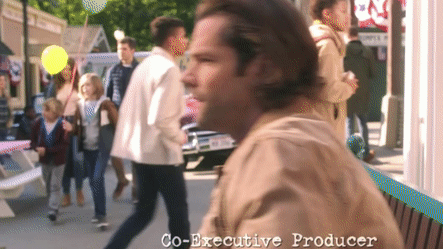
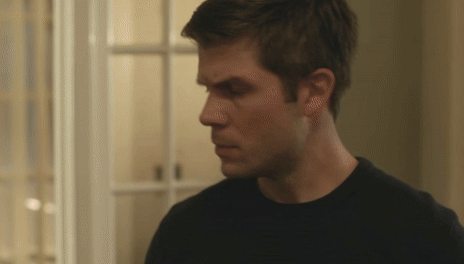
1. Castiel falls; the first line of defense
Castiel is this black-and-tan-sentry of the door. This character has slightly Jack-and-Dean-esque style in terms of style (shoes and dark shirt + jacket) but he visually dies as Castiel did in 12x23. The writers break the shield (heavenly!protector) and move into the symbolic hearth of the home. They overwork him and drain him of all vitality and happiness before he goes.
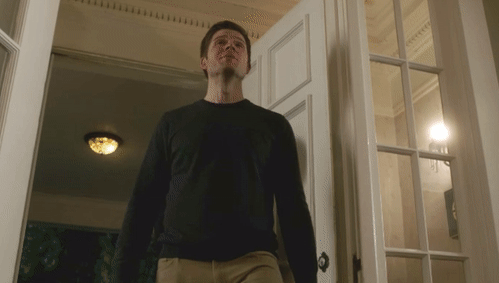

2. Dean falls next; the second line of defense
This is the character they symbolically kill, but leave (bodily) intact. The one whose tongue they cut out. (As in Proverbs 10:31, "The mouth of the righteous flows with wisdom, But the perverted tongue will be cut out." Ergo, Dean is no longer righteous. He is corrupted. Broken.) The reaction shot calls to mind the mated reaction shot to the 12x23 scene above. Sam and Dean BOTH have a reaction to Castiel being felled, but visually this character is more similar to Dean.
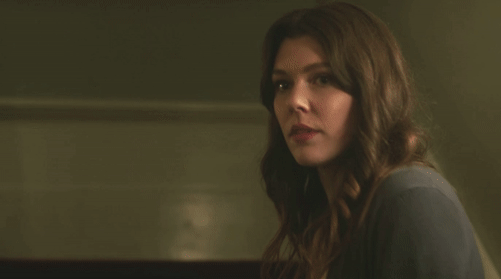
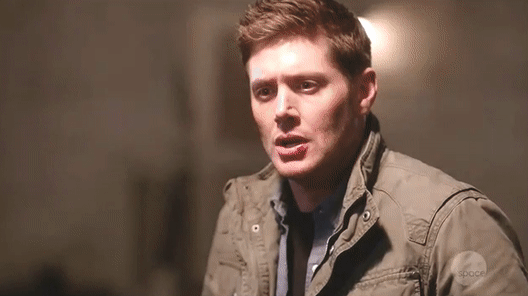
This could, of course, call to mind Kelly or Mary or even Sam, but her duster is long and gray, like a MoL robe. Below: "Lyle?" / "Cas? Where's Jack?" (Bonus: green eyes)

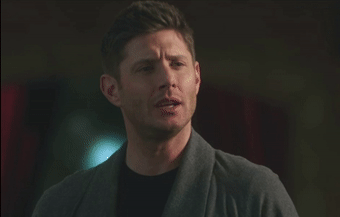
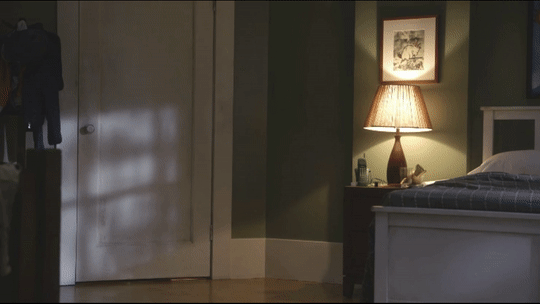
(Goodbye, Dean.)
3. Sam in despair, bunkering down with another family member, still not safe
This one is easy to see. There's long hair, and Sam is wearing the same gray hoodie in the exact same episode, perhaps the most clear visual cue of all. The child also wears an orange jacket, which is the deep amber of endurance and one of Sam’s key colors.
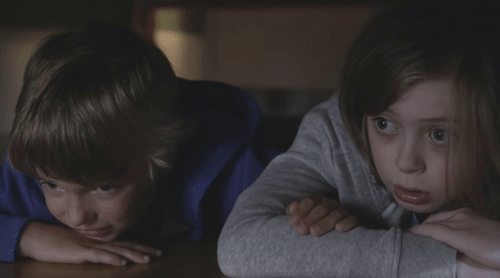
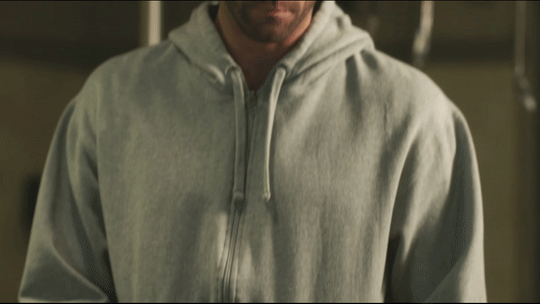
4. Jack is last family member, clothed in the garb of Heaven (deep blood + blue sky)
The last family member's got the yellow balloon and blond hair, symbolic rising sun/son (Jack). He wears slightly Chuck & human!Cas manner of dress, signaling the humanity trapped inside the divinity. Ergo, the lineage of Chuck->Cas->Jack. (The blue is Heaven, the deep red represents royalty. (Bright red is blood and sacrifice.) Ergo, “royalty of Heaven.”

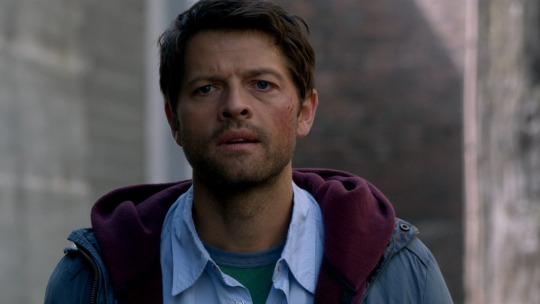

(First two images, Mikael.)
So, in the end, Sam and Jack were visually "saved," within the narrative.
But were they actually? They are both tied to destinies that feel empty and going-through-the-motions, like they're stranded on the island inside the childhood bedroom.
Symbolically, the trapped narrative almost seems to pick up where 15x18 Despair left off...

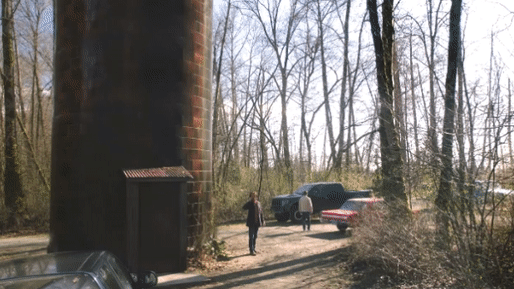

...except it continues the poofing of the loved ones, rippling outwards from Cas, before then moving to Dean, to Sam, and finally to Jack, watching as his remaining family member is dragged out from under the bed and ripped away from him.
///
It seems to suggest that, even if Cas and Dean hadn't, as Billie said, "been in the wrong place," that there was really no hope to start with. As Dean lamented, "we never should've left Sam n' Jack," like Amelia Novak lamented, "I never should've left her (Claire)." (The failed protectors’ refrain in SPN is, “I never should’ve left them!”)
But no matter where Dean and Cas were, they were never going to save Sam and Jack.
The writers were always going to win.
The ghostly specter of this episode is unsettling and unreal, oddly picturesque and "Charming Acres" -styled, like this shot reminiscent of the Monet-style painting.
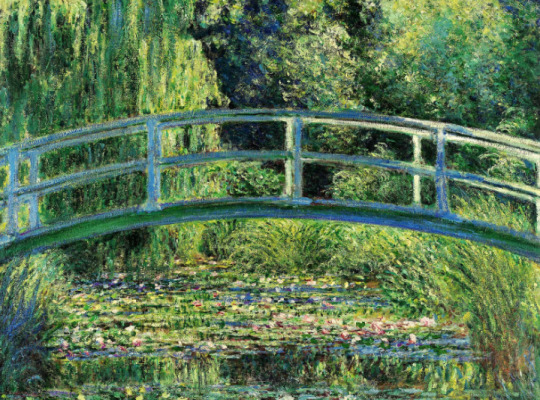

It's a false world.
("What did you do to Dean? What did you do to Sam?")
Maybe I killed them? Or...maybe you just don't recognize them. Maybe I gave them new roles when they refused to play the right ones. Who knows, Becky? All I can tell you for sure is that I won.
Charitably, maybe the fight ain't over. I offer this to Becky's "No one even mentions Cas!" It's from Ouroboros:
Castiel: It's an odd and glaring omission. Sam: No. It's our shot....yeah. I-It's risky. But I-I think it's probably our best play.
Come on, Sammy. Break out of it.
#cw spn finale#cw dean death#spn carry on#spn 12x23#chuck won theory#tfw + play your roles or perish in new ones#this has been niggling my brain for eons#i do hope you like it#i really love the parallels and it gives me something to like about the finale#chuck force fit and twisted the family structure to fit the same old story he always tells except this time both protectors die#chuck took their unique family and stripped it molded it till it fit an acceptable origin story for the new sacrifices#this was very fun to poke at despite it being the finale :-)#i don't even care if it's been done already i just wanted to have my thoughts recorded somewhere yanno?
36 notes
·
View notes
Text
"M," Evie says, voice sharp and fond all at the same time. "Babe, we talked about this. You can't just go around tackling people to the ground just because you want to. You're supposed to be a good role model for the children."
Dizzy, who to the best of Mal's knowledge is the only child currently in the house, snickers.
"I'm a great role model," Mal says, choosing not to acknowledge any evidence to the contrary. "I'm like, the best role model ever. Dizzy can back me up here. I'm the coolest, best adult she knows, right Diz?"
"Right!" Dizzy chirps, grinning. She's been experimenting with her hair recently, and the current blonde streaks make her look a little older. With them, she almost looks her actual age, which is horrifying. Cute little Dizzy is supposed to be a kid forever, and not do awful things like grow up and become independent. Mal is firmly in the camp that she's too young to have a nineteen-year-old kid, and helping Dizzy through all the things she never did, like grow up and apply to schools and study for tests and figure out how to deal with building a credit history, are so far beyond her actual comfort zone that they might as well be on the moon.
She's nowhere near responsible enough to help a whole young adult through life, but for some reason the Auradon Adoption committee didn't think things like the harrowing trials of adult life through when they granted Evie temporary guardianship of Dizzy the second that she turned eighteen, so here they are. Five years later, and hopefully not any more fucked-up than they would have been if they'd stayed on the Isle.
"Thank you," Mal says, and doesn't even grimace when she says it. That's personal growth, baybee. "Dizzy, you're my favorite now. Evie, you've been demoted to my favorite girlfriend, which is a very competitive place, and if you want to stay there, you'd better be nice to me, because I could have other girlfriends in a heartbeat if I wanted—oof!"
"Mal." Evie says very seriously, from an inch above Mal's face. "Babe. I love you, but I'm also going to murder you right here if you don't stop talking."
#dizzy is a sweet child and I love her#but also she basically got adopted by evie (and I stand by this)#so in this AU that means she’s had the wildly codependent polycule as her primary role models for most of her teenage years#she’s fine it’s all fine#she’s a very mature and competent young person now#but her adoptive guardian is NOT the height of a normal adult role model#and she probably has some guilt about making Evie’s life and schedule harder than it would have been without her there#anyway someday I’m going to type up the family structures for this AU and it’s going to be a ~nightmare~#the isle kids take a unique approach to relationships#which is mostly that you CAN cling to everyone you love#if you just try hard enough#anyway#my fic#descendants
18 notes
·
View notes
Text
"It is difficult to argue that [Edward IV] was wrong in what he did. His advancement of [Richard of Gloucester] can be criticized only by those who believe that the only good nobleman is an impotent nobleman. Medieval kings did not think in these terms. Gloucester’s power was valuable because it ensured royal control of a significant and troublesome part of the country. Nor can Edward be blamed for not foreseeing the ends to which Gloucester might put his power. The duke had been a loyal upholder of the house of York, a central figure in Edward’s polity*; there was no obvious reason why he should not occupy the same role under Edward V. In this respect, precedent was on Edward’s side. Previous minorities had seen squabbles over the distribution of power, but no young king had ever been deposed. Even royal uncles traditionally drew a line at that, something which explains why Gloucester’s actions seemed so shocking to contemporaries and, perhaps, the reason why he got away with it so easily in the short term.
In the immediate sense, Gloucester must take final responsibility for what happened in 1483. However one explains the motives behind his actions, things happened because he chose that they should: there is nothing in the previous reign which compelled him to act as he did."
-Rosemary Horrox, Richard III: A Study of Service
*Richard was also, yk, Edward's own brother who had been entirely loyal to him during his life. The problem wasn’t that Edward trusted Richard (why wouldn't he?), the problem is that Richard broke that trust in a horrible and unprecedented way to usurp a 12-year-old. Please understand the difference.
#wars of the roses#edward iv#richard iii#edward v#my post#The arguments of Ross and Pollard (et al) are so profoundly unserious and ahistorical#casting an unforeseeable turn of events as a predictable ('structural') one as David Horspool rightly puts it#Ross specifically is entirely dependent on his own horrible view of Elizabeth Woodville and her family as the basis of his analysis#but anyway. as Horrox points out later in the book:#''although earlier events [during Edward's reign] cannot be said to have caused the crisis they did have some bearing in how it developed'#namely Edward's legacy of forfeitures in the 1460s; manipulation of property descents; and fluctuating royal favour.#the most prominent and politically important of all of these were the manipulation of the Mowbray and Howard family fortunes#This is often used to enhance the unserious and ahistorical arguments of historians like Ross and Pollard that Edward doomed his son#But as Horrox points out: Edward's reign did not exist in a vacuum and needs to be analyzed by actual historical context.#from a broader perspective his actions were not especially transgressive as far as English kings were concerned#NO MONARCH (Edward III; Henry VII; etc) died with every single one of their nobles 100% content and supportive#they weren't living in Disney movies and there's no point holding Edward IV to fairytale standards that did not exist.#More importantly Horrox points out that Edward's actions (eg: the Mowbray and Howard cases) need to be put into actual perspective#They were not perceived as problems and did not cause problems during his own reign.#They did not cause problems after he died before Edward V arrived in London.#They only became problems after Richard decided to seize power and deliberately exploited them as bribes for political support#Had Richard decided to support his nephew or work with the Woodvilles - Edward's actions (@ the Mowbrays and Howards) would be irrelevant#(It's also worth pointing out that we don't know WHEN Richard decided to usurp. It if it was a more gradual desire then his depowering#of the Woodvilles by exploiting Mowbray & Howard discontent would not have not affected *Edward V's* ascension or prospects)#ie: the problem isn't that discontent existed with a few specific nobles (that was normal) the problem was how Richard took advantage of it#In theory this sort of thing would have been a potential threat for ANY heir to the throne whether they were a minor or an adult#In itself it's not really unique to Edward and it's silly when historians criticize him and him alone for it. It was more or less standard.#(if anything the fact that he was able to do them so successfully is an indication of his authority)#We come back to Horspool's point: 'Without one overriding factor' - Richard's initiative and actions - 'none of this could have happened.'#which is where this analysis of Horrox's comes in :)
5 notes
·
View notes
Text
anyway more republican art posting but. the characterization of republican art and the notions of personal appearance in that period make it so interesting to me. i think pliny said this when i was reading him talking about the ancestral imagines but he basically characterizes a 'decline' of art from the republican era to his time, essentially with art becoming less about showing the individual characteristics and personality of a person and more iconographic/about projecting things like wealth or power rather than capturing individual features. essentially he says portraits became more of a 'stereotype' which signalled what kind of person you were, rather than a portrait of your particular face. which i think, although i don't really know how right pliny was about his own time obviously, is definitely something which characterizes republican art in the cursory glance at roman art history i've taken; ie the focus on capturing idiosyncratic and individual portraits of people (even to the point of possibly exaggerating them, almost like a caricature) in order to capture almost something about their soul. i think this is why i find that era of portrait busts so alluring, and though there are also definitely imperial era ones which have the same idea of capturing an individual, the republican ones hit different imo
#pliny nat.hist. 34.4- btw#it's really interesting that this style of portraiture seems to have evolved specifically out of the republican political milieu#which is why it's so unique in terms of ancient art because other societies with different governmental structures which didn't focus so#much on individual glory but also specifically building a family legacy out of individual glory (both separate and intertwined - the family#wouldn't get you to the end but it could start you off. you still had to make your own mark to get anywhere - you couldn't always just coas#off family connections)#so it's these aristocratic dynasties but a great amount of focus on the individuals within them and how they shaped up to their ancestors#and i think this general mindset created that art style (verism) and made it very. representative of the repulican zeitgeist#even outside of that political context . it echoes it. idk. the roman urge to say look at me. im an old man. im an important old man.#a particular old man. remember every wrinkle on my old man face. yeah
1 note
·
View note
Text
Moon through the degrees
The Moon represents your emotions, intuition, subconscious patterns, and how you seek comfort and security. The specific degree of the Moon in your birth chart fine-tunes your emotional expression, sensitivity, and how you process feelings.
0° Moon – The Pure Emotional Self
• Extremely instinctive and emotionally raw.
• Feels deeply but may struggle to regulate emotions.
• Highly intuitive but needs grounding.
1° Moon – The Emotional Pioneer
• Quick emotional responses, bold in expressing feelings.
• Seeks independence in emotional matters.
• Can be impulsive in personal relationships.
2° Moon – The Emotional Stabilizer
• Strong need for security and emotional grounding.
• Loyal and committed in relationships.
• Can be resistant to change in emotional matters.
3° Moon – The Expressive Heart
• Openly shares emotions and enjoys deep conversations.
• Communicates feelings with ease.
• Needs to avoid exaggerating emotions.
4° Moon – The Protective Nurturer
• Emotionally defensive and values home/family deeply.
• Creates strong emotional boundaries.
• Can struggle with letting go of the past.
5° Moon – The Passionate Dreamer
• Emotionally intense and deeply connected to creativity.
• Seeks thrilling emotional experiences.
• Can be dramatic in expressing feelings.
6° Moon – The Sensitive Empath
• Deeply attuned to others’ emotions.
• Highly intuitive but needs to set emotional boundaries.
• Can absorb negative energy from surroundings.
7° Moon – The Spiritual Mystic
• Feels guided by intuition and higher wisdom.
• May have prophetic dreams or psychic abilities.
• Needs to balance spiritual emotions with reality.
8° Moon – The Powerful Feelings
• Emotionally resilient and determined.
• Strong emotional control, but can suppress feelings.
• Can be magnetic and influential.
9° Moon – The Free-Spirited Soul
• Emotionally adventurous and open-minded.
• Seeks new emotional experiences.
• Needs to balance emotional freedom with commitment.
10° Moon – The Devoted Caregiver
• Emotionally dedicated to family and loved ones.
• Takes responsibility for others’ well-being.
• Needs to prioritize self-care.
11° Moon – The Independent Heart
• Values emotional independence and freedom.
• Unique approach to emotions, doesn’t conform.
• Can struggle with emotional detachment.
12° Moon – The Dreamy Idealist
• Emotionally romantic and imaginative.
• Strong connection to fantasy and creativity.
• Needs to stay grounded in reality.
13° Moon – The Transformational Soul
• Experiences deep emotional changes in life.
• Intense emotions that lead to personal growth.
• Can struggle with emotional control.
14° Moon – The Magnetic Charmer
• Emotionally expressive and charismatic.
• Attracts people with their emotional energy.
• Needs to ensure authenticity in emotions.
15° Moon – The Balanced Emotion
• Strives for emotional harmony.
• Can see both sides of emotional situations.
• Needs to trust their own feelings more.
16° Moon – The Purpose-Driven Soul
• Feels called to fulfill a higher emotional purpose.
• Can be deeply devoted to a cause or mission.
• Needs to balance work with personal emotions.
17° Moon – The Fierce Protector
• Extremely loyal and defensive of loved ones.
• Can be territorial in relationships.
• Needs to balance possessiveness with trust.
18° Moon – The Thoughtful Observer
• Emotionally reflective and deep thinker.
• May struggle with expressing emotions outwardly.
• Needs to share feelings instead of bottling them up.
19° Moon – The Emotional Risk-Taker
• Seeks excitement and variety in emotional life.
• Can be impulsive in relationships.
• Needs emotional grounding.
20° Moon – The Dedicated Worker
• Emotionally invested in career or responsibilities.
• Finds comfort in productivity and structure.
• Needs to make time for emotional self-care.
21° Moon – The Creative Dreamer
• Emotionally expressive through art, music, or writing.
• Feels deeply connected to beauty and aesthetics.
• Needs to find a stable emotional outlet.
22° Moon – The Master Strategist
• Emotionally intelligent and calculated.
• Prefers thinking before reacting emotionally.
• Can struggle with showing vulnerability.
23° Moon – The Confident Heart
• Strong emotional presence and self-assurance.
• Can inspire others with their emotional strength.
• Needs to remain humble and open to emotional growth.
24° Moon – The Passionate Soul
• Feels emotions intensely and deeply.
• Puts heart and soul into relationships.
• Needs to manage emotional highs and lows.
25° Moon – The Loyal Defender
• Protects and stands up for loved ones.
• Can be emotionally possessive or defensive.
• Needs to allow others emotional freedom.
26° Moon – The Hidden Depths
• Keeps emotions private and deeply personal.
• May not express feelings outwardly but feels deeply.
• Needs to trust others with their emotional truth.
27° Moon – The Dreamer in Action
• Emotionally motivated by ideals and visions.
• Can be deeply spiritual or philosophical.
• Needs to balance imagination with practical action.
28° Moon – The Worldly Explorer
• Emotionally drawn to different cultures and perspectives.
• Open-minded and enjoys emotional variety.
• Needs a stable foundation amidst change.
29° Moon – The Karmic Soul
• Carries deep emotional wisdom from past lifetimes.
• May feel emotionally intense or burdened with lessons.
• Needs to master emotions before stepping into their full power.
1K notes
·
View notes
Text
A Workshop for Creating Magical/ Fictional Crystals: A Guide from a Geologist
Hi folks, its me, here to talk about fictional writing again! Today I'm just tackling the idea of magical stones/mana stones by looking at existing minerals today and some neat properties that they have, and how you can apply these things to a fictional world. The goal is mainly to help you if you are stuck trying to come up with a unique magic system, or a unique identification/characteristic of your mineral.
First Things First: Mineral Shapes

I am exhausted, petered out, down-right fatigued by seeing every mineral depicted with having the crystal structure of calcite and quartz. There are soooooo many cooler, more interesting crystal structures, don't you think you would stop and take a look at a perfect cube in nature? It is completely unsettling.
Second: Color
Color within minerals can either be really important, or not important at all! It is your choice to decide if color is going to be something that means something to your mineral. But what are some times when the color is important? Well.... there are some elements that are called chromophores, this classification just indicates that these elements, when present, will determine the color of whatever they are in. So, if you wanted to treat mana like a chromophore, you could say, "Oh everything that contains mana turns green!" This could mean that regardless of the mineral, if that mineral is a specific color, it means it contains mana. This concept is exciting because you can just stop here and use minerals that already exist! You can also use it as an indicator for a magical ore! Chromophores are typically metals, so if you are making a new metal weapon, making the ore of that metal a unique color would make a lot of sense!
However, your mineral can also just be every color of the rainbow like quartz and perhaps that's what makes identifying your mana stones elusive and create an illusion of scarcity that your character can solve.

There are other things that can change the colors of minerals, like radiation damage, and electron exchange, but I think that is beyond what would be helpful! So lets talk about some unique color properties that happen in nature that seem magical in the first place! Maybe you don't need to design a mana stone, but you want a unique gemstone that only the royal family passes down or something (IDK).
The first one is the alexandrite effect! This is where a mineral can change color in natural light vs. incandescent light. (the mineral itself is not changing, but the lights contain different amounts of different colors that then get absorbed by the stone). Even if you don't use electricity in your fictional world, you could have the colors change in the presence of light magic. This could create fun misunderstandings about what the mineral is reacting to!
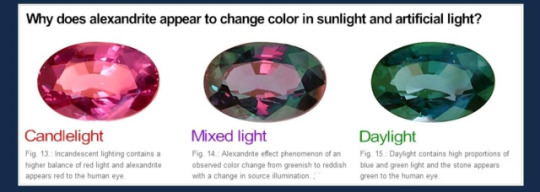
Pleochroism
Pleochroism is something that most minerals have, it is frequently used to help identify minerals in thin sections, however minerals are usually not pleochroic enough for it to be visible to the naked eye! Pleochroism is just a fancy name to describe the change in how light is absorbed based on the angle of the mineral! So if you scroll up to the first image where I showed a lot of crystal shapes, most of them have angles where they are longer and shorter! This will effect the way light travels in the crystal. Tanzanite is a popular mineral that does this.

Photochromism
This is when a mineral will change color (in a reversible way) when exposed to UV light (or sunlight), I am not going to go too into the details of why this is happening because it would require me to read some research papers and I just don't feel like it. The mineral that is best known for this is Hackmanite!
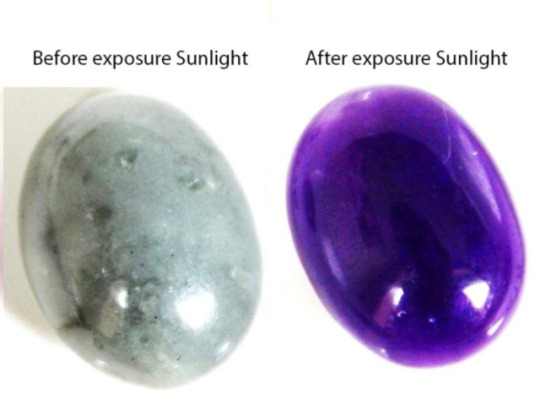
Alright! These are all the really cool color effects that might inspire you or maybe not, but now I am going to talk about how you might find your minerals within a rock!
When I see a lot of magical caves/mines, typically I see them with some variation of a geode honestly, but most minerals are not found like that! Now I am sure most of you guys have seen a geode, so I will not really talk about those, but I will talk briefly about porphyroblasts which is when the mineral grows larger than the minerals around it, this happens in metamorphic minerals!

sorry random stranger, but this is an image of garnets inside a finer-grained rock at gore mountain in New York!
Another way you might find minerals is in a pegmatite! This is when all minerals are really large! This is a formed from really slow crystalizing magma!
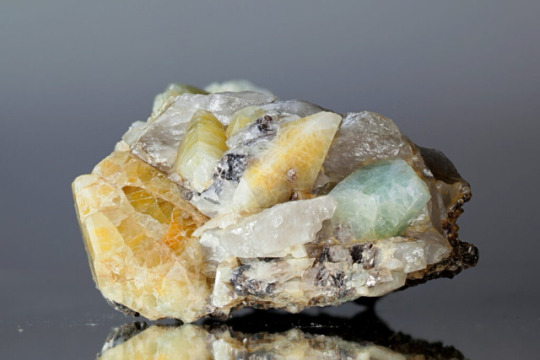
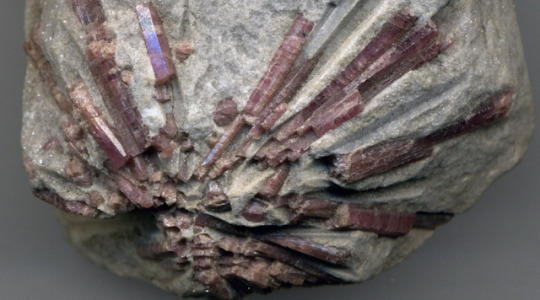
But something else to think about is that your mineral might just be massive, it doesn't have to have distinct crystals, it may be similar to jadeite where small grains grow together which leaves it looking smooth and seamless! A note about all of these is that you would have to mine into the rock to find these, there would not be any natural caves in these rocks! Caves are only ever really formed in limestones and maybe marbles (rocks that react with acid).
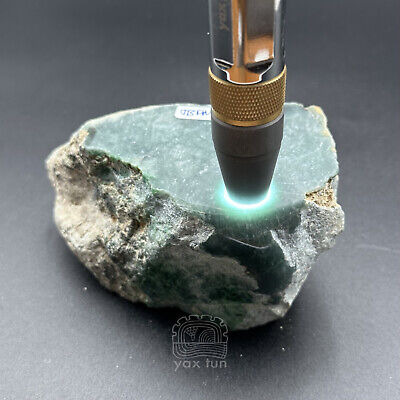
How can your characters identify these minerals?
Typically when you are out in the field you will look to see what type of rocks the minerals are found in (The overall texture of the rock will tell you how it formed). If you know how the rock formed, it will narrow down the amount of minerals you need to think about by quite a bit! Next, you are going to look closely at it and observe its crystal structure, does it have an obvious crystal? if so what is the general shape? If it is broken, how did it break? Did it fracture like glass or did it break along uniform planes. Some minerals have a thing called cleavage (breaks along planes of weakness). If a mineral exhibits this habit, it will again help narrow this down. Next we can look at color. Color can be misleading, because minerals like quartz can be any color imaginable, but minerals like olivine will always be green! The next thing your character can do is test for hardness, minerals all have a specific hardness that can help identify it as well.
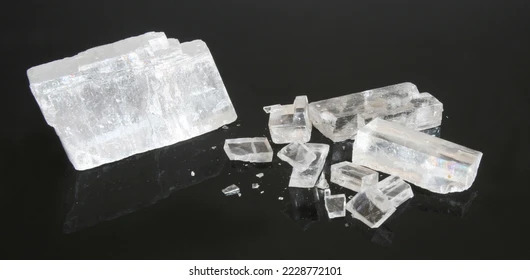
After you go through all of this, your mineral might have some special property! This could be magnetism, fluorescence, reactions to acid, or any of the color changing effects I mentioned above! Other than that, your character can take it back to a lab and do a number of things to identify it, but the most typical thing would be for them to make a thin section (very thin piece of the rock) and observe it under a cross polarized microscope!

On that note folks! I hope this helped in some way in thinking of new magic mineral properties! I have other guides that explore some different fictional worldbuilding issues you might run into, but if you have any topics you would like me to cover please that I haven't mentioned already, let me know!
#geology#rocks#creative writing#fictional world#worldbuilding#dnd#dnd worldbuilding#worldbuilding stuff#writing resources#info post#information#writing
6K notes
·
View notes
Text
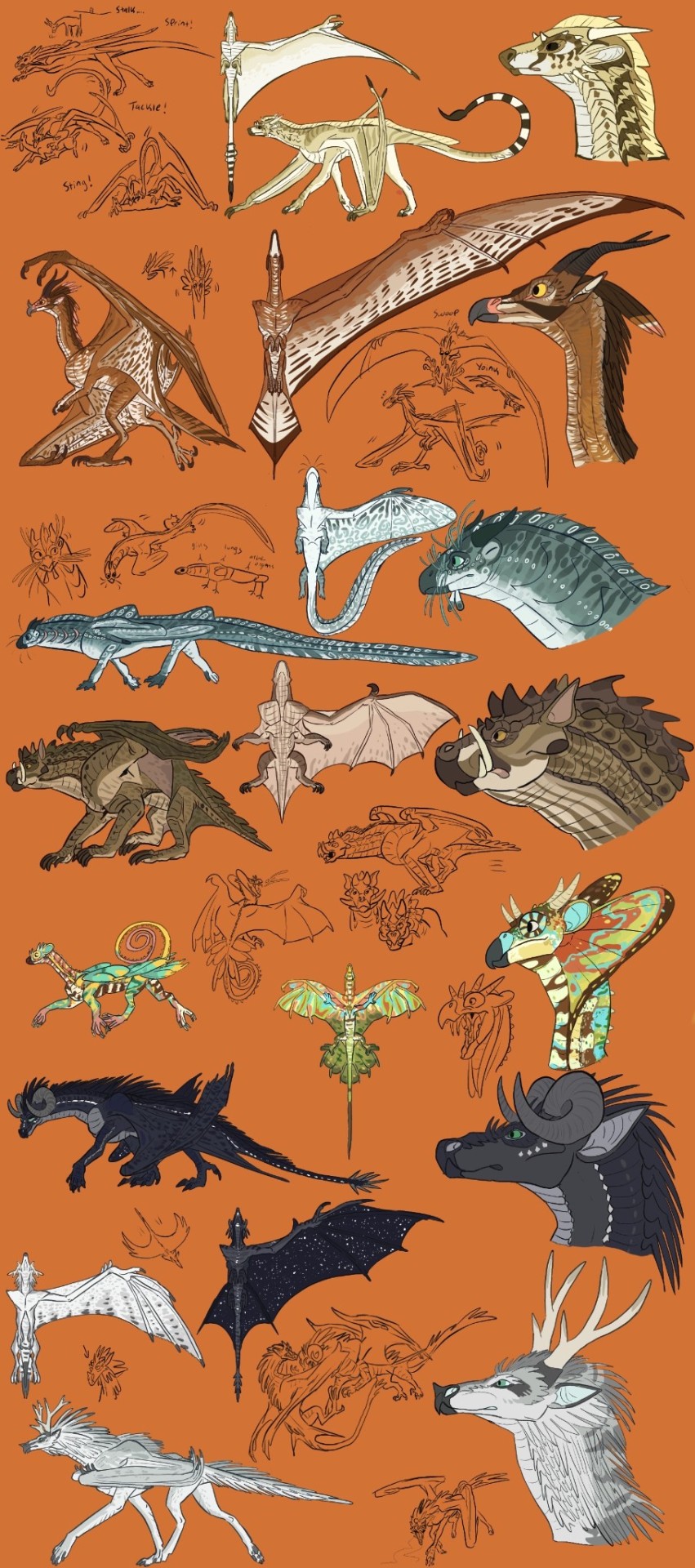
While it's on the mind, here's my wings of fire designs too. Not as much of a brainrot but still fun. Bad take or am I cooking with some of them? Let me know in the comments. Here's some (too many) notes:
I really liked the original designs when I first read these books, but I wanted to try my hand at uhh changing them a little. Mainly making them more distinct from each other (even if this irreversibly breaks canon XD)
-Sandwings live in a mixed savannah and desert habitat and have bodies adapted for resource scarcity, effective hunting, and heat dispersion. They have large ears to help cool off and listen for stuff. They can fly, but pretty weakly in comparison to some others, mainly using flight to navigate their large territories , get onto cliffs, and scan for prey. They typically climb up somewhere and then jump off. They are built like felines, and use a solo stalk and rushdown hunting approach coupled with a sting instakill. They live in family groups, with a ‘queen’ title going to the alpha female 💪 and everyone else hunting and living together. They are immune to their own venom, which acts very similarly to a scorpion’s but in a massive dose, causing numbness, breathing difficulties seizures, and eventually death. It takes time for them to make more once they’ve expended the dose, so they rarely use it outside of hunting or life/death situations (though the prospect of being stung is very scary to everyone else, and they will instinctively raise their tail when startled or threatened)
-Skywings live in high mountainous and forested areas, with some living in the lowlands. They are powerful flyers and very acrobatic due to their tail, though this comes at the expense of their agility on land and the strength of their non wing arms. They have long legs with powerful talons for grasping prey midair or snatching them from off the ground. They hunt and live alone unless they have a partner. Communities are made up of a loose group of related individuals who rarely collect in one place at once(queendom structure are a more recent and ‘unnatural’ thing for them, but very useful for organizing military efforts and empire building). They stay aloft for long periods of time and usually only land on their cliff homes. They need a sprint or a takeoff point to get flying, though. Unlike every other tribe, they have a noticeable difference between male and female (being a nose horn and red face for males.) males are prized for these features, and having a pretty husband is seen as an attractive trait for a queen.
-Seawings live along the coast. They normally only venture out of the water for trade and other resources, since they can get everything else they need underwater. Their large neck houses gills protected by thick pads that will close when on land, while their lungs are in their mid chest. Primarily adapted to swimming, they have very strong tails and webbed fingers and toes. They will also use their wings to steer and paddle, as well as manipulate things their other arms can’t reach. They will hunt in packs, corralling fish and other animals into a kill zone. They are very clumsy on land and in the air with their short limbs and weak wings. Their bioluminescent spots can be flashed for communication, and compared to the other tribes they have pretty poor vocal ability (due to the gills in their neck getting in the way) and will supplement with other spot/sign signals. Every individual has unique spots, though their glowing ones come in consistent numbers, sizes, patterns, and places on their body so they can use them for common language across their group. However, Different groups from different parts of the ocean have different numbers of spots in different areas, making cross communication via only spots difficult. Their whiskers help navigate in close or dark areas, and are seen as a status symbol.
-Mudwings live in warmer areas, specifically marshes and other wetlands (though sometimes in some forested areas too). Their thick armor helps protect them from other mudwings/competition, while also acting as an insulator that allows them to easily venture a wider range than other tribes from warm climates. Physically, they are the strongest and bulkiest. They typically use the element of surprise and their overwhelming size and strength to take down large prey. However, unlike other tribes they tend to eat more plants too due to their large size (all of them are technically omnivores, but meat makes up the dominant part of their diet because of their energy needs and their ancestors). They are also the poorest flyers out of the bunch, having sacrificed that for size and strength, though they can do short bursts similar to a chicken to get to hard to reach areas or to surprise attack prey faster than them, they’re similar to hippos and are adapted to living in the water too, using powerful webbed arms to propel themselves and dig through the mud, and their large lung capacity to stay submerged and hidden for long periods. Their nostrils, ears, and eyes are located near the top of their head, which also gives more room for Tusks. They use these to root around occasionally defend themselves. Tusk maintenance and appearance is very important to them. They live in large groups of families in the same area and have more communal social standards than other tribes.
-Rainwings live in tropical areas and have a very small habitat range. This has caused them to look and act very different than most tribes, leading to poor perception of them. They use their long claws, strong grasping fingers, and prehensile tail to climb around, and are pretty much arboreal. They have wings meant for quick takeoffs and flight in dense areas, and are pretty agile and swift. They and aren’t that great at sustained flight or dealing with high altitudes and winds though . Their frill is delicate and used for emoting (probably originally for mating purposes) Their skin is packed with chromatophores that they can use to match their surroundings, and they have loose ridges in their skin that they can raise to enhance the effect. Their skin is constantly changing color due to their brain activity, though they have set patterns/colors for emotions and communication. They can also choose to focus on organizing their skin patterns to get coordinated colors and patterns, since normally it’s pretty disorganized. They eat a lot more plants due to their environment and due to social standards, but arent herbivores. They have the ability to spit acid out of hollow retractable fangs, and use precise shots of this coupled with their camouflage ability to get prey. They can also spray it at higher velocities for defense and offense, though this expends their supply much quicker. They don’t recognize a queen in their communities and are fairly disorganized into different cooperative groups.
-Nightwings are the result of a group that split off onto an island, though the volcanic activity on their original island escalated to the point where they had to emigrate. They are great fliers, using their wings and tail extensions to travel great distances to track prey and ambush from above. When on land, they aren’t particularly fast or strong, and instead are built for persistence. Their hunting tactic involves getting an initial bite onto prey, then waiting for it to succumb to infection. Their spines, horns, muscles, and talons are mainly for defending their kill from other Nightwings rather than hunting it in the first place. As a result of this competition, they aren’t naturally very social like other tribes, They are mainly nocturnal.
-Icewings live in the colder tundras and snowy forest environments. They are pack hunters, using their speed and persistence to take down prey, similar to wolves. Their long overlapping scales help them trap heat and survive in the cold, and while the guy i drew here is pretty skinny they also store fat much more readily than other tribes. Their bowed wings are mainly used to swoop in in prey, and like falcons they often take steep dives to grapple it. Their antlers only grow in at a certain time in the year, but royalty will wear embellished artificial ones in the meantime.
#my two vasly different dragon media interests#the httyd book dragons are also intelligent but unlike the wof ones i never imagine them wearing clothes and theyre never referenced#using tools or really wearing jewlery or building things they live in packs like animals but many of them can carry on a convo with a human#comparatively id say that the main difference is that the wof have a distinct grouping and relationship between the types of dragon while#in the httyd books those guys are just Everywhere and Everything#and also Humans are a major part of httyd while theyre just kinda weird little creatures in wof#wof art#wings of fire#wof#drawing
1K notes
·
View notes
Text
The Mini Guide to Crafting Compelling Royal Characters for Fiction Writers
Creating royal characters can be both exciting and challenging. These regal figures often play pivotal roles in stories, capturing readers' imaginations with their power, privilege, and the weight of responsibility they carry. Whether you're writing historical fiction, fantasy, or contemporary novels featuring monarchs, this comprehensive (mini) guide will help you develop authentic, multi-dimensional royal characters that will resonate with your readers.
Understanding the Basics of Royalty
Before diving into character creation, it's essential to have a solid grasp of what royalty entails. Royalty typically refers to members of a ruling family, including kings, queens, princes, princesses, and other nobles within a monarchical system. These individuals are often born into their roles, though some may ascend to power through marriage or other means.
Key aspects to consider:
Hierarchy and succession
Royal duties and responsibilities
Protocol and etiquette
The concept of divine right (in some cultures)
The relationship between royalty and their subjects
Remember, while these elements are common in many royal systems, you have the creative freedom to adapt or reimagine them for your fictional world.
Developing Your Royal Character's Background
Every character, royal or not, needs a rich backstory. For royal characters, this background is particularly crucial as it shapes their worldview, values, and decision-making processes.
Consider the following:
a) Lineage: What is your character's family history? Are they from a long-standing dynasty or a newly established royal house?
b) Upbringing: How were they raised? Were they groomed for leadership from birth, or did they have a more sheltered upbringing?
c) Education: What kind of education did they receive? Was it formal, focusing on statecraft and diplomacy, or more well-rounded?
d) Relationships: How do they relate to their family members, courtiers, and subjects?
e) Personal experiences: What significant events have shaped their character and outlook on life?
Crafting a Unique Personality
Avoid the trap of creating one-dimensional royal stereotypes. Your character should be as complex and nuanced as any other well-developed protagonist or antagonist.
Consider these aspects:
a) Strengths and weaknesses: What are your character's admirable qualities? What flaws do they struggle with?
b) Motivations: What drives them? Is it a sense of duty, personal ambition, or something else entirely?
c) Internal conflicts: What personal struggles do they face? How do these conflicts affect their rule and relationships?
d) Hobbies and interests: What passions do they pursue outside of their royal duties?
e) Sense of humor: How do they express humor, if at all? Is it dry wit, sarcasm, or something else?
Balancing Power and Vulnerability
One of the most intriguing aspects of royal characters is the juxtaposition between their immense power and their human vulnerabilities. This balance can create compelling internal and external conflicts for your character.
Consider:
The weight of responsibility and its impact on their personal life
The isolation that often comes with a royal position
The constant scrutiny they face from the public and court
The struggle between personal desires and duty to the crown
Creating a Believable Royal World
Your royal character doesn't exist in a vacuum (I hope not). They're part of a larger royal ecosystem that includes family members, advisors, courtiers, and subjects. Developing this world adds depth and authenticity to your story.
Key elements to consider:
Court dynamics and politics
Relationships with other noble houses or kingdoms
The role of advisors and how they influence decisions
Traditions and customs specific to your royal setting
The economic and social structure of the kingdom
Addressing the Challenges of Royal Life
Royal characters face unique challenges that can drive your plot and character development. Some common themes include:
a) Succession disputes b) Balancing personal happiness with duty c) Navigating political alliances and conflicts d) Managing public opinion and maintaining legitimacy e) Dealing with threats to their rule or life
Use these challenges to create tension and drive your story forward while revealing more about your character's personality and values.
The Impact of Historical Context
If you're writing historical fiction or a fantasy inspired by real-world monarchies, it's crucial to consider the historical context. Research the time period and culture you're drawing from to ensure authenticity in your character's behavior, beliefs, and challenges.
Key areas to research:
Social norms and expectations of the time
Political systems and power structures
Technology and its impact on governance
Religious beliefs and their influence on royalty
Gender roles and how they affect royal duties and succession
Avoiding Common Pitfalls
When creating royal characters, be mindful of these common mistakes:
a) Making them too perfect or too villainous b) Ignoring the realities of royal life (e.g., lack of privacy, constant duties) c) Overlooking the impact of their decisions on their subjects d) Failing to show growth or change over the course of the story e) Relying too heavily on stereotypes or clichés
Incorporating Royal Etiquette and Protocol
Royal characters often adhere to strict codes of conduct and protocol. While you don't need to become an expert in royal etiquette, incorporating some of these elements can add authenticity to your story:
Forms of address (Your Majesty, Your Highness, etc.)
Court ceremonies and rituals
Dress codes and regalia
Rules of precedence in social situations
Diplomatic protocols when interacting with other royals or dignitaries
Exploring Different Types of Royal Characters
Remember that not all royal characters need to be ruling monarchs. Consider exploring other royal roles, such as:
The rebel prince or princess who rejects their royal duties
The reluctant heir thrust into power unexpectedly
The exiled royal fighting to reclaim their throne
The royal spouse adapting to life in the palace
The illegitimate child discovering their royal heritage
Each of these archetypes offers unique storytelling opportunities and challenges for character development.
Balancing Historical Accuracy and Creative License
If you're writing historical fiction featuring real royalty, you'll need to strike a balance between historical accuracy and creative interpretation. While it's important to respect known facts and timelines, you also have the freedom to explore the inner lives and motivations of these historical figures.
Tips for balancing accuracy and creativity:
Thoroughly research the historical figure and their time period
Clearly differentiate between historical fact and fictional interpretation
Use author's notes to explain any significant departures from known history
Focus on filling in the gaps in the historical record rather than contradicting established facts
Developing Royal Character Arcs
Like any well-rounded character, your royal protagonist should undergo growth and change throughout your story. Consider how their experiences might challenge their beliefs, alter their perspective, or force them to confront their flaws.
Possible character arcs for royal characters:
From naive idealist to pragmatic ruler
From reluctant heir to confident leader
From isolated monarch to connected leader who understands their subjects
From power-hungry tyrant to benevolent ruler (or vice versa)
Remember, character growth doesn't always have to be positive. Sometimes, the most compelling stories involve characters who face moral decline or tragic falls from grace.
Remember, while the trappings of royalty may be grand, at their core, your royal characters are still human. They love, fear, hope, and struggle like anyone else. It's this humanity, set against the backdrop of power and responsibility, that makes royal characters so fascinating to read and write about.
Happy writing, - Rin T
Hey fellow writers! I'm super excited to share that I've just launched a Tumblr community. I'm inviting all of you to join my community. All you have to do is fill out this Google form, and I'll personally send you an invitation to join the Write Right Society on Tumblr! Can't wait to see your posts!

#writing#creative writing#thewriteadviceforwriters#writing tips#writers block#writeblr#how to write#writers and poets#writers on tumblr#on writing#royalcore#royalty#romance writing#writing advice#writing blog#writing guide#writing inspiration#writing ideas#writing reference#writing resources#writing software#writing tools#writer#writing life#writing help#writing community#writing characters#novel writing#fiction writing#writing a book
2K notes
·
View notes
Text
"Blended Families: Nurturing Love And Harmony In A Complex Family Structure"
'Blended Families: Nurturing Love And Harmony In A Complex Family Structure' invites you to join the journey of harmony, resiliency, and unwavering love. Create a legacy of unity that crosses boundaries as you celebrate the beauty of various connections.
Introduction: When varied hearts come together to form blended families, a great beauty is revealed in the beautiful tapestry of life. The tenacity of love, the strength of acceptance, and the ability to create harmony among the difficulties of a particular family structure are all demonstrated by blended families. It’s a voyage that goes beyond expected lines of demarcation and redefines the…

View On WordPress
#Blended family dynamics#Complex family structures#Embracing diversity in families#Embracing the unique journey of a blended family
0 notes
Text
★⋆ Lilith in the signs⋆ ★

Lilith (black moon Lilith) is representative of Lilith, Adam's first wife in mythology. She refused to submit to Adam and therefore was cast away from heaven. She represents our shadow self what we repress and hide but is our ultimate power. Lilith in Aries - Fiercely independent, strong-willed, and refuses to be controlled -Rejects authority and thrives on personal freedom -They be insecure about their sense of self and may go to extremes to prove their identity Lilith in Taurus - Deeply sensual, drawn to physical pleasure and indulgence. -Struggles with attachment to material possessions or stability. -May resist societal expectations around beauty and self-worth. - May overindulge in luxuries and become lazy. Lilith in Gemini -A master of words, seduction through intellect, and questioning societal norms. - Can feel silenced or struggle with duality in self-expression. - Might reject conventional education or traditional ways of thinking. - This could also indicate troubles with siblings. Lilith in Cancer -Deep emotional intensity, challenging traditional family roles. - Struggles with feeling nurtured or safe, often rejecting dependence on others. -May have a complicated relationship with motherhood, family, or home life.
Lilith in Leo -A rebellious performer, naturally magnetic but refuses to conform. -Struggles with ego, validation, or the need to be recognized. -Can reject traditional ideas of success and embrace their own unique path. - Might have felt looked over and ignored, desired notoriety. Lilith in Virgo -Rejects societal pressures for perfection and order. -Can struggle with anxiety, self-criticism, or rigid expectations. -May embrace alternative healing, sexuality, or spirituality to break free from control. - Shame in cleanliness, might feel 'dirty'. Lilith in Libra - Challenges traditional relationship norms, refuses to be “owned” by a partner. -Can struggle with balancing independence and intimacy. -May use charm and beauty as a tool for rebellion. - Tendency to have forbidden thoughts and is more likely to engage in taboo relationships. Lilith in Scorpio -Embodies deep sexual power, mystery, and transformation. -Unafraid of taboo topics, death, and rebirth. -Can struggle with power struggles, obsession, or manipulation. - Deep sense of loss of power, these people crave to control and dominate. Lilith in Sagittarius -Fiercely free-spirited, rejects societal restrictions on beliefs and travel. -Struggles with commitment and being tied down. -Can be drawn to forbidden knowledge, philosophy, and spiritual rebellion. - Might feel misunderstood by family, might not resonate with religion. Lilith in Capricorn - Defies authority, corporate structures, and traditional success models. -May struggle with control issues or rejecting responsibility. -Can be a powerhouse when embracing their own rules for success. -Might have been put down for their ambition, they have the power to rise to the top and become the best Lilith in Aquarius -A true revolutionary, challenges norms and embraces eccentricity. -Struggles with feeling like an outsider or rejecting belonging. -Can be a genius when breaking boundaries in technology, art, or activism. Lilith in Pisces - Rejects religious or spiritual dogma, drawn to mystical or altered states. -Struggles with escapism, addiction, or losing themselves in dreams. -Can harness immense creative and intuitive power when grounded.
705 notes
·
View notes